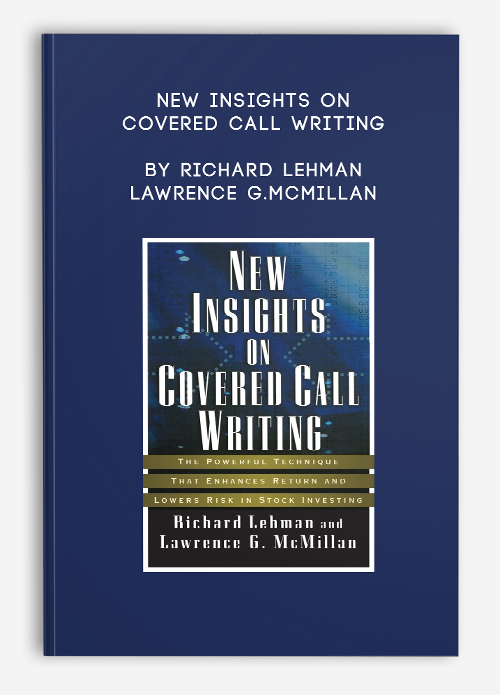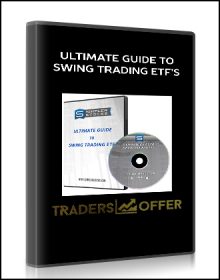New Insights on Covered Call Writing by Richard Lehman, Lawrence G.McMillan
$25.00

New Insights on Covered Call Writing by Richard Lehman, Lawrence G.McMillan
Get New Insights on Covered Call Writing at Salaedu.com
Forex Trading – Foreign Exchange Course
You want to learn about Forex?
Foreign exchange, or forex, is the conversion of one country’s currency into another.
In a free economy, a country’s currency is valued according to the laws of supply and demand.
In other words, a currency’s value can be pegged to another country’s currency, such as the U.S. dollar, or even to a basket of currencies.
A country’s currency value may also be set by the country’s government.
However, most countries float their currencies freely against those of other countries, which keeps them in constant fluctuation.
Description
Does this sound like you?
- You want the long-term returns from stocks but don’t like the volatility.
- You like the security of income from bonds and CDs, but the yields are too low.
- You wish there was a sensible discipline you could follow that would provide the attractive returns offered by common stock yet with more consistency and less risk.
If so, then covered call writing may be the investment strategy you’ve been looking for.
You can achieve long-term returns commensurate with stock market returns but with lower volatility and less downside risk. The trick is to combine stocks with call options by “writing” a call against a stock you already own. Professional investment managers have been using this strategy for years, and recent developments have now made it easier for individual investors to employ it as well. Options experts Richard Lehman and Lawrence McMillan unlock the secrets of covered call writing in this groundbreaking, easy-to-understand guide.
Table of Contents
Preface.
Introduction.
Part I: BUILDING THE FOUNDATION.
CHAPTER 1: Option Basics.
What Are Options?
How Options Compare with Stock.
Standardization.
Listed versus Unlisted.
Option Listings.
Strike Price.
Expiration.
Players and Positions.
Exercise and Assignment.
The Basic Mechanics.
What Happens at Expiration.
Covered versus Naked.
Options in Your Account.
Recapping Option Basics.
CHAPTER 2: Just Beyond the Basics.
Valuing Options.
Fair, or Theoretical, Value.
Volatility.
Interest Rates.
Dividends.
Theory versus Reality.
Trading Symbols.
Adjustments.
Expiration Months.
How Options Are Traded.
The Exchanges.
Computerized Quotes.
Liquidity.
Recapping Just Beyond the Basics.
CHAPTER 3: Covered Writing Mechanics.
Requirements for “Valid” Covered Writes.
Risk/Reward of a Covered Write.
Risk/Reward Characteristics Over Time.
Risk Transference.
Shorting a Call versus Shorting a Stock.
More on Exercise and Assignment.
Calculating Potential Returns.
Return if Exercised (RIE).
Return Unchanged.
Return Based on Net Debit.
Part II: EXECUTING THE STRATEGY.
CHAPTER 4: Turning a Position into a Strategy.
A New Way of Thinking.
Follow-up Actions.
The Simple Case: Doing Nothing until Expiration.
Closing Part or All of the Position.
Rolling Options.
Rolling Up.
Rolling Up and Out.
Rolling Down.
Rolling Out.
Other Considerations.
Covered Call Strategies.
The Total Return, or “Buy-Write,” Approach.
The Incremental Approach.
Hedging Individual Stocks.
Reducing Risk in Small Portfolios.
Writing Calls on “Hot” Stocks.
Tax Deferral Strategies.
CHAPTER 5: The Benefits of Covered Writing.
The Rationale Behind Covered Writing.
Realistic Expectations.
Call Writing and Stock Returns.
Major Factors Affecting Call Writing Returns.
Stock Selection.
Strike Price.
Expiration.
Volatility.
Interest Rates.
Transaction Costs.
Covered Writes Compared with Stocks Over Time.
The BuyWrite Index (BXM).
Real-World Results for Twenty Stocks.
Results by Calendar Year.
Effects of Writing a Higher Strike Price.
Recapping Benefits.
CHAPTER 6: Intangible Benefits.
What is Long Term, Anyway?
The Covered-Write Solution.
The Benefits in Detail.
CHAPTER 7: Implementation.
Deciding on Your Approach.
Incremental Writing.
Traps Involved in Writing for Incremental Return.
The Total-Return Approach.
Traps in the Total-Return Approach.
Are You a Fundamentalist or a Technician?
Selecting Stock Positions.
Searching All Stocks.
Searching Specifically for Covered Writes.
Selecting Calls to Write.
Which Strike Price?
Which Expiration Month?
Getting Your Ducks in a Row with Your Brokerage.
Full-Service versus Discount Brokers.
Online Brokers.
Financial Planners.
Which Account to Use?
Writing Calls on Your Employer’s Stock.
Keeping Records.
Placing Orders.
Market and Limit Orders.
Stop Orders.
Buy-Write Orders.
Using Spread Orders When Rolling.
Risks.
Basic Tax Rules for Options.
Precepts for Covered Call Writers.
CHAPTER 8: Advanced Implementations.
Covered Writing on Margin.
Margin Rules for Covered Writes.
Advantages of a Margined Covered Write.
Covered Writing against Securities Other than Stock.
Covered Writing on “Diamonds,” “Qs,” and Other ETFs.
Writing Calls against Convertible Securities.
Writing Calls against Other Options—The “Call-on-Call” Covered Write.
Covered Writing on LEAPS.
Partial Writing, Mixed Writing, and Ratio Writing.
Partial Writing.
Mixed Writing.
Ratio Writing.
Put Writing.
Advantages of Put Writing.
Disadvantages of Put Writing.
Implied Volatility and Overvaluations.
Efficiency, Inefficiency, and Overvaluation.
Expiration Games.
Option-Stock Arbitrage.
CHAPTER 9: Tools for Covered Writers.
Option Chains.
Search Tools.
Calculators.
Probability Analysis.
Industrial Strength Option Software.
What Will This Cost You?
Internet Resources for Covered Call Writers.
Afterword.
Appendix A: Timeline of Options Trading in the United States.
Appendix B: Sample Covered Writing Spreadsheet for Tax Purposes.
Appendix C: Tax Rules for “Qualified” Covered Call Options.
Appendix D: Twenty-Stock Covered Call Study.
Bibliography.
Glossary.
Index.
Author Information
Richard Lehman has more than twenty-five years of experience applying his expertise in options strategies. He has held executive positions at E. F. Hutton, Thomson McKinnon Securities, First Saxonia Securities, and at the New York Stock Exchange. As an independent adviser, he now runs an online advisory service at CoveredWriter.com.
Lawrence G. McMillan is recognized as one of the foremost options trading experts. He has written three best-selling books on options, including Options as a Strategic Investment. As president of McMillan Analysis Corporation, he writes the “Daily Volume Alerts” and edits and publishes The Option Strategist, a derivative products newsletter covering equity, index, and futures options, as well as the online resource OptionStrategist.com.
Reviews
“This book makes a great case for basic reading and writing–reading stock charts and writing covered calls.”
—John Murphy
President, MurphyMorris Money Management
Chief Technical Analyst, StockCharts.com
“This was a definite eye-opener, and one of the soundest approaches to stock investing I’ve seen. It makes you wonder what else Wall Street has been keeping from us.”
—Brian R. Workman
Senior Vice President, Citi Cards, Citigroup
“In a low-return, high-volatility environment, these strategies can boost returns and lower risk. There is no such thing as a free lunch, but in this case all the lunch costs is a little initiative.”
—Stephen M. Savage
Managing Director, Litman/Gregory Analytics
“This book has the most complete and comprehensive coverage of covered call investing that I have seen. Most books discuss covered calls as just one of many option techniques. This book goes the extra mile. It discusses the theoretical aspects of covered calls and also provides the practical tools any investor would need to effectively implement a covered call trading strategy.”
—Ernie Zerenner
President, Power Financial Group, Inc.
Get New Insights on Covered Call Writing by Richard Lehman, Lawrence G.McMillan at Salaedu.com
1 review for New Insights on Covered Call Writing by Richard Lehman, Lawrence G.McMillan
Add a review Cancel reply
Related products
Forex - Trading & Investment
Forex - Trading & Investment
Forex - Trading & Investment
Forex - Trading & Investment
Michael Parsons – Channel Surfing Video Course (Manual,Video)
Forex - Trading & Investment










Trevis Trevis –
We create this shop with the mission: Bring the courses to 500 millions of people in the world, to help them awake their power and change their